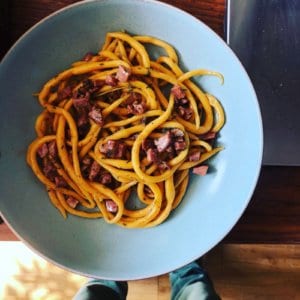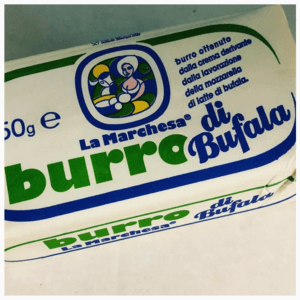Motor City and Mort… followed by Picci
 Italian Americans are responsible for all manner of minor, cross-cultural disgraces; Spaghetti and meatballs, chicken parmigaaan and most of the cast of Jersey Shore. However their early experiences in the new world and its seemingly never ending supply of meats, cheese, sweets and booze, left a few hybrid diaspora dishes that could never have happened in the relative poverty of the old country
Italian Americans are responsible for all manner of minor, cross-cultural disgraces; Spaghetti and meatballs, chicken parmigaaan and most of the cast of Jersey Shore. However their early experiences in the new world and its seemingly never ending supply of meats, cheese, sweets and booze, left a few hybrid diaspora dishes that could never have happened in the relative poverty of the old country
A couple of years ago I was asked to come up with a dish for BBC Children in Need’s Carfest Festival. It was, I assumed, a simple enough brief; two recipes to fit a 45 minute slot, that was until my PA told me they were looking for some kind of car/automobile twist. Now I like cars; I like how you can wedge yourself firmly into the passengers seat off a Golf and catch a good hours kip, the little illuminated horse that appears on the pavement when you open the door of a mustang, or how a Fiat Punto retains its street cred even when its spent a lifetime taking more of a battering than a sub average boxer. I am not the kind of person however who knows what “Torque” is and always lament the fact that there are no horses actually involved in horsepower. If you show me a top of the range Ferrari, Im most likely to compliment the choice of magic tree. I had to turn to history to find the perfect dish.
I began with Enzo Ferrari as the man was from Emilia-Romagna and to date, I haven’t met a single sole from the region, who didn’t have anything short of a Paolo and Francesca style love affair for food. Alas, it seemed he lived of Prosciutto and torta fritta whilst he wiled away the hours in his workshop tinkering with carburettors and exhaust pipes . As much as I find the idea of frying square after square of enriched bread dough in hot pig fat about as joyful as waking up to find that my metabolism has advanced to the pace of a teenage race horse, I didn’t think it would make for much of a show.
In vain I scoured the internet, googling F1 drivers and their favourite foods despite my knowledge of the sport probably being classed as “Junior Scaletrix Level” It turned out that a lot of the icons of the 1970s lived off a heady mixture of booze, late nights and the occasional hit of narcotics, whereas today’s drivers followed a diet similar to that of a Scandinavian racing sardine. Eventually I hit upon the idea of the people who actually build the cars..
Italian car workers were every employers dream in Detroit during the 1920’s. They worked hard, caused little fuss and instead of high wages, safe working environments and discounts on Ford Model T’s, all they demanded was a little macaroni and meat for lunch. Mortadella, that wonderful cylindrical Roman invention of Peppa-pig pink meat, lipid white islands of belly fat and acrid bursts of black pepper corns was cheap to produce and cheap to supply, so became the natural choice to accompany the lunchtime macaroni.
This dish is a simple plate of hand made Pici pasta, a little butter, thyme, finely chopped mortadella, pecorino and a little honey to cut through this thick, fatty mantle that coats the fresh pasta. Pici may seem like a weird choice for the sauce as the mortadella has very little chance of getting a firm hold onto the dough, but the rather nice thing is that each strand is coated in a delicate emulsion of butter infused with the earthy mortadella and accompanying flavours. What you are left with at the end is a satisfying little pile of buttery meat that slaps you round the face for a slice of bread to make an ad hoc mortadella roley.
Good Appetite
 Serves 2.
Serves 2.
For the dead simple pasta part:
150g 00 flour, we love to use Molino Quaglia
150g fine semola (optional, but will give your pasta more bite) again Molino Quaglia
180g egg yolk (save the whites for meringues or Rocky style gym fuel)
For the sauce/emulsion
20 Pistachio, shelled and crushed as fine as you can be bothered (30 to make up for the 10 you will invariably eat)
2 Sprigs of fresh thyme
1 Tablespoon of honey
30g good breadcrumbs (avoid the day glow fish finger kind)
10g of butter, use burro di bufala
Half and onion
Evoo, Eleusi is great and its from Calabria
1/3rd of a block of pecorino cheese (or any hard Italian cheese)
Method
- Today we are making PICCI. Think relatively long, slightly fat/thin mis-shapen spaghetti you do by hand. It rocks. Start by combining the flour and semolina in a bowl, make a well in the centre and add the egg yolks. Use a fork and bring the flour into the egg and mix well. If the mix is too dry add a tiny bit of water just until it comes together.
YOU WANT TO MAKE A DOUGH SIMILAR IN LOOK AND FEEL TO PLAYDOUGH
- Once this is done, form into a nice square or round and dust with flour. Cling film and leave in the fridge for minimum half an hour.
- When the dough is rested, tear grape sized balls off (keep the dough covered) and roll onto a clean surface (if you dust them or your hands in more flour, it wont work) You want to create long, knobbly worms (think like a long spaghetti Nick-Nack)
- Once all the dough is done, let these dry a little while you do the sauce
- Very finely mince the onion and sweat it in the butter and olive oil until translucent. add half the leaves of the thyme and half the thinly sliced/fine chopped mortadella and cook on a low heat.
- Bring water to the boil in a sauce pan, remember to salt the water well, and add your pasta for 5-6 minutes.
- Remove the pasta and pop straight into the pan, retaining one cup of that pasta water elixir.
- Keep the pasta moving, add half the pistachio and grate as much cheese as you fancy, add some of the pasta water to form a sauce and a little black pepper.
- Using a fork, twist the picci into a tight ball and place in a bowl, finish with more fresh mortadella, thyme, pistachio and the breadcrumbs, drizzle of olive oil,
- Now you are done.

 It started with a satisfying itch in the centre of my chest during a meal of pork more bereft of moisture than a saharan salt cod factory. Overnight, I assumed that this little red blob the exact shape of Sardinia was nothing more than a heat rash probably triggered by my body’s complete shock and awe that the UK, in 2018, had managed to climb into the near sub equatorial figures of 11 degrees in the hours of darkness. I started to worry more on the train; I was tired, itching was coursing across my upper torso and my shoulder felt like it had been used for tackling practice by Millwall FC. My landlady, a reputable woman with the medical knowledge of a village witch-doctor and the hypochondria of an Italian mamma knew immediately I was a mass of shingles and low morale.
It started with a satisfying itch in the centre of my chest during a meal of pork more bereft of moisture than a saharan salt cod factory. Overnight, I assumed that this little red blob the exact shape of Sardinia was nothing more than a heat rash probably triggered by my body’s complete shock and awe that the UK, in 2018, had managed to climb into the near sub equatorial figures of 11 degrees in the hours of darkness. I started to worry more on the train; I was tired, itching was coursing across my upper torso and my shoulder felt like it had been used for tackling practice by Millwall FC. My landlady, a reputable woman with the medical knowledge of a village witch-doctor and the hypochondria of an Italian mamma knew immediately I was a mass of shingles and low morale. I’ve recently started using a lot of buffalo milk butter from Italy; it’s a bright marble white pat with the depth and richness of lard and that mouth insulating warmth that usually proceeds the magic of streaky bacon, belly pork or an overly buttered crumpet. It’s perfect for tossing with some fresh pasta, a little pinch of salt, a really fatty slab of mortadella chopped fine and a sprinkle of pecorino. I have also started throwing in a knob with some finely chopped onions and letting them sweat before drowning it all in torpedino tomatoes and letting it cook on a low heat slowly, before tossing it through with some rigatoni and pecorino. It might not be the classic Pasta Pomodoro, but I’m sure it can be added to the legion of recipes that over the years, have built up around that particular dish and its variants.
I’ve recently started using a lot of buffalo milk butter from Italy; it’s a bright marble white pat with the depth and richness of lard and that mouth insulating warmth that usually proceeds the magic of streaky bacon, belly pork or an overly buttered crumpet. It’s perfect for tossing with some fresh pasta, a little pinch of salt, a really fatty slab of mortadella chopped fine and a sprinkle of pecorino. I have also started throwing in a knob with some finely chopped onions and letting them sweat before drowning it all in torpedino tomatoes and letting it cook on a low heat slowly, before tossing it through with some rigatoni and pecorino. It might not be the classic Pasta Pomodoro, but I’m sure it can be added to the legion of recipes that over the years, have built up around that particular dish and its variants.